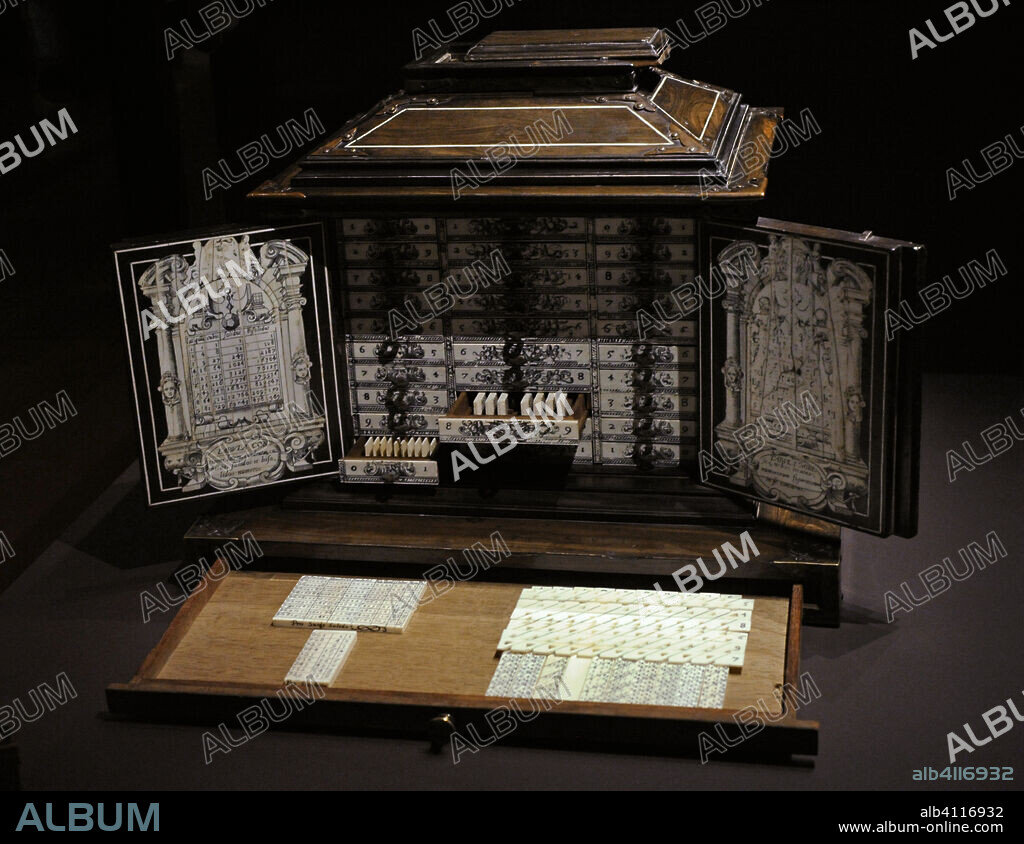alb4116932
Napier's calculating machines, 17th century (after 1617). In a case with doors and thirty drawers are kept the counters of two abacuses, designed by the Scottish mathematician John Napier (1550-1617). The first abacus consists of sixty numbered rods, called "Napier's bones". It was widely spread in Europe, being used as a portable abacus until the 18th century. The second one, called promptuary, is composed of about three hundred numbered and perforated strips for fast multiplications. Verawood with ivory inlay. National Archaeological Museum. Madrid. Spain.

|
Zu einem anderen Lightbox hinzufügen |
|
Zu einem anderen Lightbox hinzufügen |



Haben Sie bereits ein Konto? Anmelden
Sie haben kein Konto? Registrieren
Dieses Bild kaufen

Untertitel:
Siehe automatische Übersetzung
Napier's calculating machines, 17th century (after 1617). In a case with doors and thirty drawers are kept the counters of two abacuses, designed by the Scottish mathematician John Napier (1550-1617). The first abacus consists of sixty numbered rods, called "Napier's bones". It was widely spread in Europe, being used as a portable abacus until the 18th century. The second one, called promptuary, is composed of about three hundred numbered and perforated strips for fast multiplications. Verawood with ivory inlay. National Archaeological Museum. Madrid. Spain.
Standort:
National Archaeological Museum. Madrid. Spain.
Bildnachweis:
Album / Prisma
Freigaben (Releases):
Model: Nein - Eigentum: Nein
Rechtefragen?
Rechtefragen?
Bildgröße:
4016 x 3101 px | 35.6 MB
Druckgröße:
34.0 x 26.3 cm | 13.4 x 10.3 in (300 dpi)
Schlüsselwörter:
17. JAHRHUNDERT • 17. JH. • ABAKUS • APPARAT • BRETT • EUROPA • EUROPAEER (F M) • EUROPAEER • EUROPÄER (F M) • EUROPÄER • EUROPÄISCH • GESCHICHTE • HOLZ • INSTRUMENT • INSTRUMENT: WISSENSCHAFT • MATHEMATIK • MOBILIAR • MOEBEL • MULTIPLIKATION • MÖBEL • NATIONAL ARCHAEOLOGICAL MUSEUM. MADRID. SPAIN. • NUMERIERUNG • RECHENBRETT • RECHENMASCHINE • SCHOTTLAND • SCHUBLADE • SCOTLAND • THEATERLOGE • TUER • TÜR • TÜRE • TÜREN • WISSENSCH. INSTRUMENT • WISSENSCH.: MATHEMATIK • ZEITGESCHICHTE
 Pinterest
Pinterest Twitter
Twitter Facebook
Facebook Link kopieren
Link kopieren Email
Email
